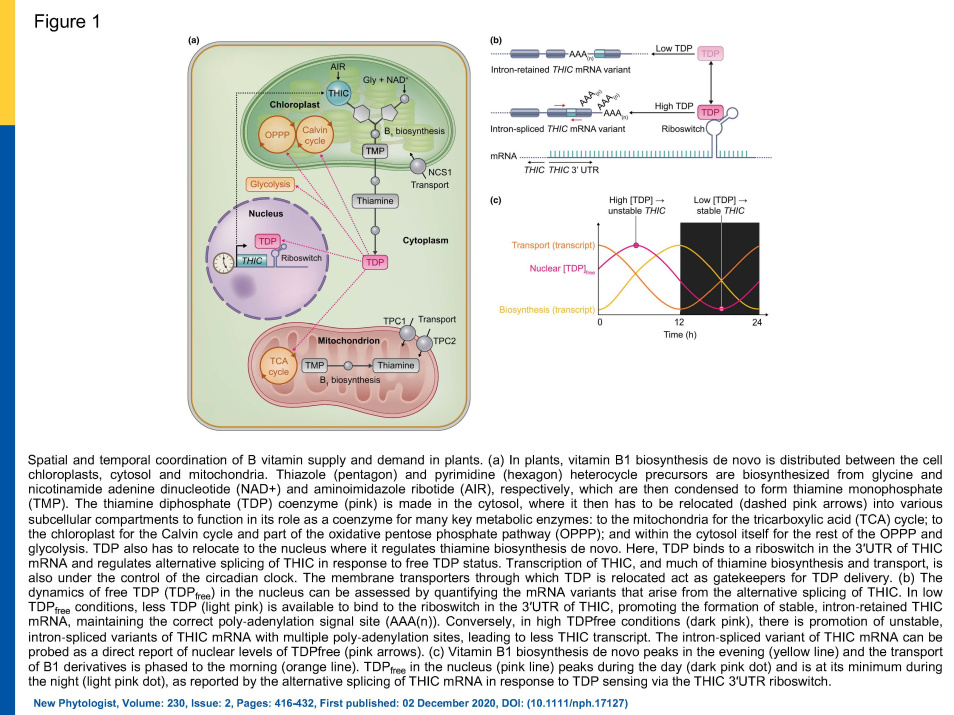Consumption of vitamin B1, also known as thiamine, is essential for human nutrition and health, with the predominant dietary source of thiamine derived from plant-based foods. However, thiamine is also a vital micronutrient for plants; thiamine diphosphate (TDP) is well characterized in its role as an essential coenzyme to enzymes in central metabolism, including carbon assimilation and respiration pathways. Thiamine is also involved in plant defense and improves responses to both biotic and abiotic stress. Depletion of thiamine in plants with mutated biosynthetic pathways significantly reduces plant fitness, causing chlorotic and stunted growth phenotypes or lethality. Similarly, thiamine deficiencies in humans can be deadly, with wide impacts on cardiovascular and neurological function, including Beri-beri disease. Research into thiamine vitamer compounds in plants therefore offers dual applications, with potential to both improve crop and human health. Work from the Fitzpatrick lab has been instrumental in characterizing thiamine biosynthesis (1,2,3), repair (4,5) and transport (6) in plants (Figure 1). These advances in understanding how thiamine is produced in plants have paved the way for genetic engineering strategies to produce thiamine biofortified staple crops (7,8,9,10). Recently, research has focused on understanding circadian regulation of thiamine metabolism (11,12) and characterizing novel non-coenzyme forms of thiamine in plants (13). We recently wrote reviews on these topics (14,15).
The Fitzpatrick lab is actively working on elucidating the broad and exciting physiological roles of thiamine vitamers, their unique regulation, and possible functions in plant metabolism.

1) Raschke M., Burkle L., Muller N., Nunes-Nesi A., Fernie A.R., Arigoni D., Amrhein N. & Fitzpatrick T.B.: Vitamin B1 biosynthesis in plants requires the essential iron sulfur cluster protein, THIC. Proceedings of the National Academy of Sciences USA (2007), 104(49):19637-19642. PMID: 18048325 .
2) Coquille S., Roux C., Fitzpatrick T.B. & Thore S.: The last piece in the vitamin B1 biosynthesis puzzle: structural and functional insight into yeast 4-amino-5-hydroxymethyl-2-methylpyrimidine phosphate (HMP-P) synthase. The Journal of Biological Chemistry (2012), 287(50):42333-43. PMID: 23048037 .
3) Coquille S., Roux C., Mehta A., Begley T.P., Fitzpatrick T.B. & Thore S.: High-resolution crystal structure of the eukaryotic HMP-P synthase (THIC) from Arabidopsis thaliana. Journal of Structural Biology (2013), 184(3):438-44. PMID:24161603 .
4) Colinas M. & Fitzpatrick T.B.: Natures balancing act: examining biosynthesis de novo, recycling and processing damaged vitamin B metabolites. Current Opinion in Plant Biology (2015), 25:98-106. PMID: 26005929 .
5) Fitzpatrick T.B. & Thore S.: Complex behavior: from cannibalism to suicide in the vitamin B1 biosynthesis world. Current Opinion in Structural Biology (2014), 29C:34-43. PMID: 25260119 .
6) Martinis J., Gas-Pascual E., Szydlowski N., Crèvecoeur M., Gisler A., Bürkle L., Fitzpatrick T.B.: Long distance transport of thiamine (vitamin B1) is concomitant with that of polyamines in Arabidopsis. Plant Physiology (2016), 171(1):542-53. PMID: 27006489 .
7) Mangel N., Fudge J., § Fitzpatrick T.B., Gruissem W., § Vanderschurem H.: Vitamin B1 diversity and characterization of biosynthesis genes in cassava. Journal of Experimental Botany (2017), 68(13):3351-3363. PMID: 28859374. (§co-corresponding authors)
8) Van Der Straeten D., Fitzpatrick T.B., De Steur H.: Editorial overview: Biofortification of crops: achievements, future challenges, socio-economic, health and ethical aspects. Current Opinion in Biotechnology (2017), 44:7–10. PMID:28342725 .
9) Pourcel L., Moulin M. & Fitzpatrick T.B.: Examining strategies to facilitate vitamin B1 biofortification of plants by genetic engineering. Frontiers in Plant Science (2013), 4:160. PMID: 23755056 .
10) Fitzpatrick T.B., Basset G.J., Borel P., Carrari F., Dellapenna D., Fraser P.D., Hellmann H., Osorio S., Rothan C., Valpuesta V., Caris-Veyrat C. & Fernie A.R.: Vitamin deficiencies in humans: can plant science help? Plant Cell (2012), 24(2):395-414. PMID: 22374394
11) Rosado-Souza L., Proost S., Moulin M., Bergmann S., Bocobza S., Aharoni A., Fitzpatrick T.B., Mutwil M., Fernie A.R., Obata T.: Appropriate thiaminpyrophosphate levels are required for acclimation to changes in photoperiod. Plant Physiology (2019) , 180(1):185-197. PMID: 30837347
12) The coenzyme thiamine diphosphate displays a daily rhythm in the Arabidopsis nucleus. Communications Biology (2020), 3(1):209.
13) On the nature of thiamine triphosphate in Arabidopsis. Plant Direct (2020), 4(8):e00258.
14) : The importance of thiamine (vitamin B1) in plant health: From crop yield to biofortification. The Journal of Biological Chemistry (2020), 295(34):12002-12013.
15) New Phytologist (Tansley review) (2021), 230(2):416-432.